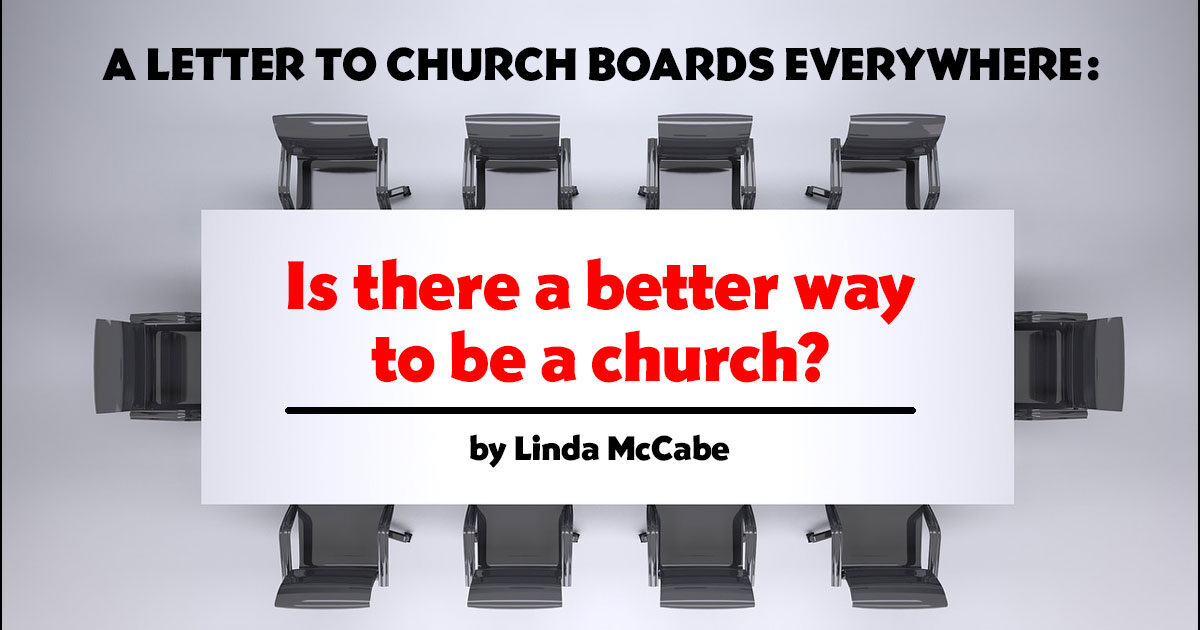To Church Boards Everywhere: Is there a better way to be a church?
by Linda McCabe | 27 March 2025 |
Once upon a time there was a church. (I won’t give the name or location, but the story is true. Anyway, it is similar enough to many other stories across the land that there is little danger of your identifying it.)
Forty to fifty members in a large Adventist church in a large city in the United States decided to plant a new church in an affluent suburb that had no Adventist presence. They had a desire to reach that community for Christ.
It was the 1940s. The move was made, the membership grew, and in time a church building project was undertaken. After the church was built, an elementary school followed, with several local churches sharing the financial load. Later the working relationship with the other churches fell apart and the school was sold. The church fixed up the basement and had school there for a while. Attendance ebbed and flowed, but typically remained between 75 and 150.
Move ahead to the 1970s and ’80s. The school closed and the church began dwindling. When they had a pastor who was well-liked, attendance went up. When that pastor left, attendance dropped. When they had a pastor who was progressive, the more traditional members left. A more traditional pastor followed, and the members who liked the progressive pastor left.
Seventy years passed. And again, about 50 members a week were meeting in the church—the same number that they started with. Although they had had a “presence” in their town for seven decades, the reality was that their church could close its doors and very few in town would even notice.
If you were to read the board minutes from years past, 95% or more of the discussions and decisions were focused on internal issues, not their community. It takes time and energy to make sure the bills are paid, the Sabbath program runs smoothly, the lawn is mowed and the building is maintained.
They really did want their church to grow, and so they brought in a consultant to answer their question: “How can we reach this community for Christ?”—which was the same question they asked when they started 70 years before. The consultant told them that the church building needed to be remodeled to make it more presentable and updated: handicapped accessible bathrooms, new kitchen, etc. They were, after all, in an affluent suburb. Over half a million dollars was committed to the project, and the work began.
I haven’t heard how the remodel affected their mission, but hearing it made me ask a different question.
Building-centered ministry?
Here’s my question: Could we come up with a more ineffective or financially inefficient way to make disciples if we tried? Millions of dollars were spent during those 70 years in pastoral salaries, building construction, maintenance, repair, and renovation. Why is it assumed that this is the only way to be a church?
I am not saying that people’s lives weren’t positively affected through the years at that church. Nor am I saying that what they did was wrong. But seriously: is there another way? A better way? Especially in today’s world, where increasing numbers of Americans are deciding not to be a part of an institutional church?
Our traditional way of doing church automatically leads us into a purchase of a church or a building program. We automatically think that we are not a “real” church if we don’t have the sanctuary and the fellowship hall and a mortgage. But does it have to be that way? Maybe in years past that was the way to enter and impact a community. But is it the best way now?
I found a website that walks you through the costs of building a new church building and I ran the numbers. A facility that would seat 150 could be in the $1-1.5 million range. The parking lot alone could cost $60,000. And I can tell you from experience that once a church family begins to focus on building, everything else takes second place.
For decades, the typical congregation will be raising money to build, then building, then paying off the mortgage, then funding repairs to the roof and the parking lot, and then 15–20 years down the road remodeling and updating a building that will be open just a few hours a week—and most of the people using it are already Adventists.
So is there a different model? A way to enter our community to build relationships and meet the needs without spending millions of dollars on a building?
My idea
I told you this is a true story. So let me switch from the general to the personal—not “they,” but “we.” Here are my ideas, based on a lifetime of observing and participating in churches and building projects.
God asked Moses what he already had in his hand. What, as a group, do we have already at hand?
Most of us are over 50. We can’t attract young families to our active childrens’ Sabbath Schools like the church up the road. We don’t have Pathfinders for the youth. Our music won’t bring out the young adults.
But the one thing we have is life experience and knowledge. We know things—things that other people would like to know. And we care about people. Most of us could give a couple hours a week to teach someone something they would like to know.
What if we were to lease a building in town? Not in the best part and not in the worst part. Not a huge, expensive building. It could be a rather small, plain storefront—but near where people are. We could call it something simple like “Community Learning Center” and offer interactive classes, mentoring every day in subjects like personal finance, basic health topics, basic mechanics, first aid, grief recovery, divorce recovery, an exercise class, crocheting and knitting, urban community gardening, English as a second language, parenting, how to play the guitar, cake decorating, or whatever skill that one of us has that we are willing to teach one to ten people how to do. Not fancy. Just teaching what we know.
My husband and I learned early on that we preferred outreach programs that had a low preparation-to-interaction time ratio. Working for days and weeks to prepare for a big impact program, where people came and watched and listened, then were gone, gave little time to interact personally. Plus they were exhausting. Simple programs and classes where you met several times over several weeks without a lot of set-up and take-down meant more opportunity to get to know people per hour of preparation. To build relationships. A bigger return on investment, as it were.
If we advertise a particular class and no one comes, that is okay. Try a different class. It would take time for the community to believe that there are no strings. And time for us to get to know people. Find out what they do, where they live, how we can help them.
The Community Learning Center could be open weekly for a book club. Or a 12-step group. Or once a week for a jam session. Anyone who plays or used to play an instrument could come hang out and play with or listen to others who play. Seniors can come and crochet hats for babies in the hospital for a couple of hours. Moms with babies and toddlers could come and we could mentor them and talk about what babies learn at different stages, and ways to help their brains grow.
Members (and community volunteers) could get together to fix a roof or a leaky faucet for a senior citizen, or have an oil change event for single moms. “Oh, and by the way, we get together for a Bible study and a meal every Saturday. You are welcome to come join us!”
What—no preacher?
We wouldn’t need a church service with a preacher. We could sit in a circle. Sing some songs. Talk to God. Discuss a Bible passage. Eat a meal together. Something that a person who didn’t want to go to “church” could participate in comfortably. Being church, rather than having church or doing church.
Imagine our doors open for 20+ hours a week. Not all of us would be there at once. Each of us might spend 3-5 hours teaching one class and being there on Sabbath. Some might spend more if they wanted to.
Imagine spending a fraction of that $1.5 million, not to build and furnish a building, but to build people. Even just $25,000 a year to assist senior citizens. To help families. To teach and mentor. What kind of impact might we have on a neighborhood or community? Yes, that sounds like a lot of money. But if we can’t come up with $25,000 a year for community projects, how can we justify spending a million to build a building and tens of thousands to maintain it and pay the bills?
“Christ’s method alone will give true success in reaching the people. The Saviour mingled with men as one who desired their good. He showed His sympathy for them, ministered to their needs, and won their confidence. Then He bade them, ‘Follow Me.’
“There is need of coming close to the people by personal effort. If less time were given to sermonizing, and more time were spent in personal ministry, greater results would be seen. The poor are to be relieved, the sick cared for, the sorrowing and the bereaved comforted, the ignorant instructed, the inexperienced counseled. We are to weep with those that weep, and rejoice with those that rejoice. Accompanied by the power of persuasion, the power of prayer, the power of the love of God, this work will not, cannot, be without fruit.” Ministry of Healing, p. 143
I understand that many will not be interested in or comfortable with my ideas—and that’s okay. There are people for whom traditional church is rewarding and treasured—there are many places for them to go to experience that type of church.
But do we need more of the same thing?
 Linda McCabe is a Georgia-Cumberland Conference assistant auditor and treasurer trainer. She lives in Tennessee. She is mom to two grown sons and one Catahoula dog named Maggie. She enjoys growing things, nature photography, hiking and biking with friends, and writing.
Linda McCabe is a Georgia-Cumberland Conference assistant auditor and treasurer trainer. She lives in Tennessee. She is mom to two grown sons and one Catahoula dog named Maggie. She enjoys growing things, nature photography, hiking and biking with friends, and writing.




